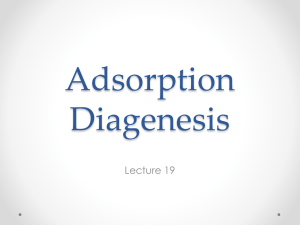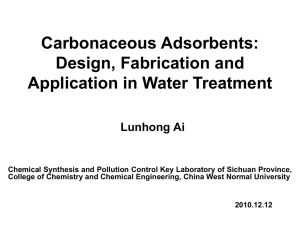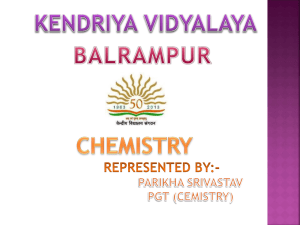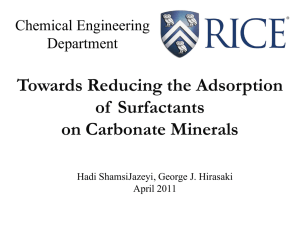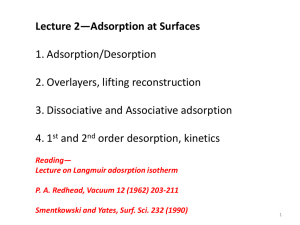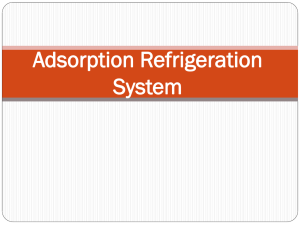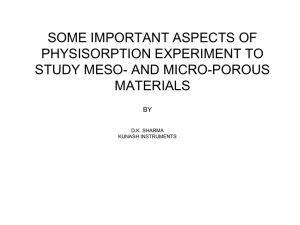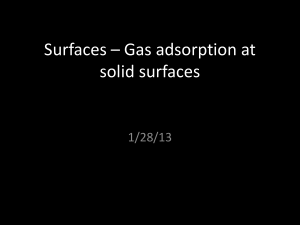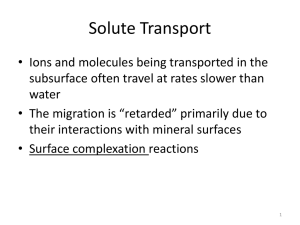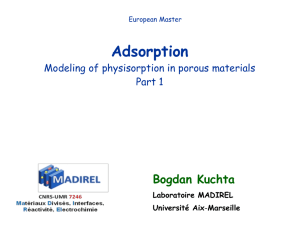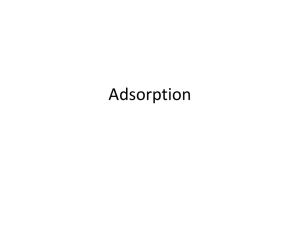Adsorption_2 - Bogdan Kuchta
advertisement
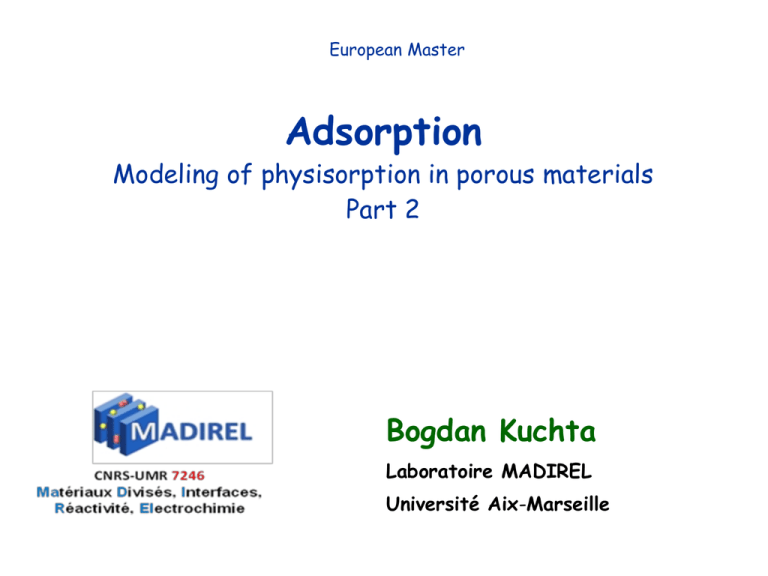
European Master Adsorption Modeling of physisorption in porous materials Part 2 Bogdan Kuchta Laboratoire MADIREL Université Aix-Marseille Typical hysteresis of adsorption-desorption cycle H1 H2 H3 H4 n / ms p / p0 Hysteresis loops H1 and H2, are characteristic for isotherms of type IV (nanoporous materials). Loop of hysteresis H1 shows nearly vertical and parallel branches of the loop : it indicates a very narrow distribution of pore sizes. Loop of hysteresis H2 is observed if there are many interconnections between the pores. Typical hysteresis of adsorption-desorption cycle H1 H2 H3 H4 n / ms p / p0 Loops of hysteresis H3 et H4, appear on isotherms of type II where there is no saturation. They are not always reproducible. Loop of hysteresis H3, is observed in porous materials formed from agregats, where the capillary condensation happens in a non-rigid framework and porosity not definitly defined. Loop of hysteresis H4 are often observed in structures built from planes that are not rigidly n p/p0 n p/p0 n p/p0 n p/p0 n p/p0 Theories of adsorption Frundlich model Langmuir model BET Theory of adsorption by Freundlich: x – adsorbed mass x/m = c1/n m – mass of adsorbent c – concentration , n – experimental constants x/m lg(x/m) c Conclusion: adsorption is better at higher pressure lg(c) Langmuir theory bp n nm 1 bp n nm - 1 one type of » adsorption sites" 1.2 - No lateral interactions 1 - 1 site of adsorption allows 1 particle to be there: adsorption is limited to one layer 0.8 0.6 N s = number of adsorption sites N a = number of adsorbed molecules 0.4 = fraction of the surface covered 0.2 0 Pression Langmuir theory Isotherm of Chemisorption at low pressure bp << 1, so Henry’s law n n bp at high pressure, bp >> 1, si n n m m bp n n 1 bp b K exp m E / RT Langmuir isotherm : influence of the coefficient ‘b’ 1 n/ n m 0.8 0.6 b=0.01 b=0.01 b = 0.1 b=0.01 b = 0.1 b=1 0.1 b=1 b = 10 0.4 0.2 0 0 bp n n 1 bp m 100 200 300 Pression 400 500 Variations on Langmuir and Henry Henry n kH p Freundlich n k H p1/ m Langmuir Sips (Langmuir-Freundlich) Toth Jensen & Seaton n bp nL 1 bp n (k H p)1/ m nL 1 (k H p)1/ m n p nL (b p m )1/ m k p H n k H p 1 a(1 p) m 1/ m Variations of Langmuir and Henry n p nL (b p m )1/ m 1 n bp nL 1 bp 0.8 n k H p1 / m n / nm n (k H p )1/ m nL 1 (k H p )1/ m 0.6 k p H n k H p 1 a (1 p ) 0.4 0.2 Henry Freundlich Langmuir Toth Sips Seaton 100 200 300 Pression 400 n kH p 0 0 m 500 1 / m Methode « BET » Théorie de Brunauer Emmett et Teller (BET) • Hypothèses – - 1 one type of » adsorption sites" - No lateral interactions } E1=energy of adsorption of the first layer – Starting from the second layer E1EL energy of molecules in liquid state Basic hypothesis of the BET theory EL 1 B E1 Energy of adsorption Relative pressure p/p° E1 = Energy of adsorption for the first layer El = Energy of liquid state Basic hypothesis of the BET theory so s1 s2 s3 A surface so covered with 0 adsorbed layers ... s1 ... 1 ... ... ... ... si ... i Accessible surface A = so + s1 + … + si + ... For s0 Derivation of the BET formula Rate of condensation of an empty surface = for s1 Rate of evaporation from the surface covered with two layers = Rate of evaporation from a surface covered with one layer Rate of condensation on the surface covered with one layer General, in the case of si Rate of condensation on a surface = covered with i layers Rate of evaporation from a surface covered with i+1 layers ki si-1 p = k-i si Derivation of the BET formula ki si-1 p = k-i si Total surface of adsorbent A s i ~ nm i 0 n nm Total quantity of adsorbed gas is i i 0 s i i 0 Asuming, that the layer properties are all the same k p si i si 1 p xi si 1 ou xi gCi (T ) k i si xi si 1 k i gCi (T ) ; i 1 ki C1(T)=exp(-E1/kT) Ci(T)=exp(-EL/kT) p EL E1 E L Cx s0 ; x exp ; C exp g kT kT i Derivation of the BET formula n nm is C i i 0 i 0 si ix i i 1 i 1 1 C ixi xi i 1 xi x i 1 n Cx nm (1 x)(1 x Cx ) À p° : Cx (1 x)(1 x Cx) donc : x p p0 x (1 x) 2 1 1 x Theory of Brunauer Emmett and Teller (BET) • Equations – N= number of layers E1 E L C exp RT n Cx 1 ( N 1) x N Nx N 1 nm 1 x 1 (C 1) x Cx N 1 x = p/p0 = relative equilibrium pressure – if N n Cx nm (1 x)[1 x(C 1)] – Transformed equation BET x 1 C 1 x n(1 x) nmC nmC Influence of number of layers N on the shape of isotherms of adsorption (BET) N=7 4 N = 25 à N=6 N=5 3 N=4 2 n Cx 1 ( N 1) x N Nx N 1 nm 1 x 1 (C 1) x Cx N 1 1 p / po 0 0 0.2 0.4 0.6 0.8 1 Influence of the constant ‘C’ on the shape of isotherms of adsorption (BET) 5 4.5 4 C = 0.1 C = 0.1 CC==10.1 C C == 10.1 CC==10 1 C 1 C == 10 CC==100 10 C = 100 C = 1000 3 2.5 a n /n a m 3.5 2 1.5 1 0.5 0 0 0.2 0.6 0.4 p / p° 0.8 1 n Cx nm (1 x)[1 x(C 1)] Application for calculation of the adsorption surface example : alumin NPL / N2 / 77 K 350.08 200 35 y = 89.95x + 1.31 y = 93.59x + 0.94 x 1 C 1 a a x a n (1 x) nmC nmC a a.(1-x) -1 xxa///nnmmol n .(1-x)g 180 0.07 3030 160 0.06 2525 140 0.05 120 2020 0.04 100 1515 80 0.03 60 10 100.02 40 5 50.01 20 0 000 000 0 C 1 nmC 1 nma C Pente : + 1.16 y = 91.52x a Ordonnée : 0.2 0.1 0.05 0.2 0.05 0.1 0.4 0.4 0.15 0.15 0.20.6 0.6 0.2 0 p / p° p° p / p p / p° 0.25 0.8 0.80.3 0.25 0.3 1 n 0.011 PO P C 1 70 O a m 11 0.35 0.35 Verifications of BET results example : alumin NPL / N2 / 77 K nma 0.011 0.016 0.014 -1 a n / mmol g C 70 nma 0.012 0.01 1 ( p / p) n a 0.107 m C 1 0.008 0.006 0.004 0.002 0 0 0.05 0.1 0.15 0.2 p / p0 0.25 0.3 0.35 Lateral interactions Normal interactions Simulation of adsorption 1. Calculation of energy of adsorption 2. Simulation of isothermes (with different strength of interaction) 3. Analyse the results 1. Simulation Monte Carlo grand canonique (GCMC) 2. Tool: program GCMC (Fortran) Numerical challenge: 1. Simulations of equilibrium between gas and adsorbed phase 2. Modeling of interaction between pore walls and adsorbed particles Working case: MC simulation of adsorption in a pore Problem: Fluid adsorption in cylindrical pores. Grand Canonical Monte Carlo VT- constant (gas) = (adsorbate) (gas, ideal) = 0(gas) + kBT ln(P) VT PVT - constant External ideal gas pressure P Working case: MC simulation of adsorption in a pore 4,0 P1 and T fixed 3,5 Density 3,0 R (radius) 2,5 2,0 1,5 1,0 0,5 0,0 20 6 10 5 0 P2 and T fixed 5 R (radius) 4 Density 15 3 2 1 0 20 15 10 5 0 Working case: MC simulation of adsorption in a pore 1400 1200 T = const 1000 <N> 800 600 400 p 0.05 0.1 0.2 0.3 0.4 0.5 0.7 0.8 0.9 <N> 234.7 362.8 385.8 401.9 421.2 448.3 558.3 691.6 1259.1 16.2 7.6 5.8 6.9 9.7 13.2 31.6 26.7 8.3 200 0 0.0 0.2 0.4 0.6 Pressure 0.8 1.0 Directory Run program (compiled) input files gcmc_H2.dat gcmc_H2_par.dat pos_inp.dat spline* execute Results files ene.ini ene.fin mc.pos mc_ene.dat mc_ent.dat pos_inp.res - initial molecular energies - final molecular energies - molecular position after each bin - energies after each bin (wall and total) - energies - analysis of results Rename : pos_inp.res OK STOP NO pos_inp.dat mc.pos 20 15 N y 1 154 10.886520 -14.887360 10.898990 14.983010 14.028510 11.913710 -14.459990 11.605350 1.908520 18.285780 1.256716 -18.238170 13.606980 -12.499060 -15.536920 -9.600965 -15.764630 -9.760927 -4.318254 -17.841070 15.933630 -9.115001 …………. …….. 10 z 9.244424 21.000650 2.990251 .722188 22.916110 4.253842 7.607756 16.492660 24.275380 23.939530 17.567660 Nbin = 1 N = 154 Y Axis Title Nbin x 5 0 -5 -10 -15 -20 -20 -15 -10 -5 0 5 10 15 20 X Axis Title 20 15 10 Y Axis Title 20 15 Nbin = 2000 N = 615 Y Axis Title 10 5 5 -5 -10 0 -15 -5 -20 -10 Nbin = 1000 N = 258 0 -20 -15 -10 -5 0 5 X Axis Title -15 -20 -20 -15 -10 -5 0 5 X Axis Title 10 15 20 10 15 20 Equilibrium situation -200 1400 -400 1200 T = const -600 Energy 1000 p 0.05 0.1 0.2 0.3 0.4 0.5 0.7 0.8 0.9 <N> 234.7 362.8 385.8 401.9 421.2 448.3 558.3 691.6 1259.1 16.2 7.6 5.8 6.9 9.7 13.2 31.6 26.7 8.3 600 -800 -1000 400 -1200 200 -1400 0 0.0 0.2 0.4 0.6 0.8 1.0 -1600 0 2000 Pressure 4000 6000 8000 10000 6 MC steps/10 500 Mean values Variation -337.7 -1160.2 -1497.9 13.5 15.3 10.2 400 300 N <N> 800 200 100 234.7 16.2 0 0 2000 4000 6000 8000 6 MC steps/10 10000 Experimental results of adsorption Milestones results 1. Isotherms 2. Energy of adsorption 3. Hysteresis properties Approach thermodynamic – energie of adsorption = g u +pv -Ts = ug +pvg - Tsg u-Ts = ug +RT - Tsg (v = 0, pvg =RT) sg=sg,0 – R ln(p/p0) adsh = u- ug - RT const. adss0 = s - sg,0 const. ads h ln p RT 2 T Adsorption is a phenomenon exothermic !!! ln ln p u σ u g RT s σ s g,0 0 RT R p p ads h ads s 0 0 RT R p ln p ads h R 1 T RT1T2 p2 ads h ln T2 T1 p1 Approach thermodynamic – energie of adsorption n ms T1 T2 > T1 Isosteric enthalpy p2 T1.T2 adsh R. . ln T2 T1 p1 n / m s p1 p2 p Basic types of adsorption energy curves Curves 3 and 4 correspond delocalized and localized adsorption on a homogeneous surface, with lateral interactions between molecules. adsh 4 Curve 2 appears in homogeneous systems with no lateral interaction. 3 2 5 1 Curve 5 shows an existence of well defined fomains. Curve 1 is characteristic for heterogeneous surfaces. p/p0 Example: mesoporous system: MCM-41 et 77K CO & CH4 20 CO Typical for heterogeneous surface 16 -adsh / kJ.mol -1 Kr ads . h (2 kJ.mol-1) during the capillary condensation 12 Kr CH4 adsh (5 kJ.mol-1) . the capillary during condensation solidification ? 8 4 0 0.2 0.4 0.6 na/nap/p°=0.4 0.8 1 Milestone properties Capillary condensation is accompnied with histeresis of variable form 40 Ar 35 900 30 vol.adsorbé /cm .g (STP) 800 na / mmol.g -1 60 100 600 3 -1 700 500 400 300 200 25 20 N2 15 10 100 5 0 0 0,2 0,4 0,6 p/p0 0,8 1 0 0 0.2 0.4 0.6 0 lichrospher p/p CPG 0.8 1 Milestone properties Hysteresis disappears at some high temperature Argon / MCM41 (Morishige et al) Milestone properties For each temperature, there is a size of pore (and/or equilibrium pressure), that the hysteresis disappears below this value. Argon Nitrogen 1.2 1 1 0.8 0.8 a 0.9 n /n 0.4 2.5 nm 4.0 nm 4.6 nm 0.6 a 2.5 nm 4.0 nm 4.6 nm 0.6 a n /n a 0.9 1.2 0.4 0.2 0.2 0 0 0 0.2 0.4 0.6 p / p° 0.8 1 0 0.2 0.4 Llewellyn et al., Micro. Mater. 3 (1994) 345. 0.6 p / p° 0.8 1 Adsorption - Desorption Isotherms : MCM41 à 77K 20 Ar N2 CO 10 a n / mmol.g -1 15 5 0 0 0.2 0.4 p / p0 Llewellyn et al., Surf. Sci., 352 (1996) 468. 0.6 0.8 1 Nitrogen / black of de carbon (Carbopack) 0.2 0.1 a n / mmol.g -1 0.15 0.05 0 0.00001 0.0001 0.001 0.01 0.1 1 p / p° M. Kruk, Z. Li, M. Jaroniec, W. B. Betz, Langmuir 15 (1999) 1435-1441. Adsorption on precipitated silica Isotherms : N2 & Ar à 77K P. J. M. Carrott & K. S. W. Sing, Ads. Sci. Tech., 1 (1984) 31. na / mmol g-1 7 300°C 6 200°C 110°C 25°C 5 4 3 2 1 p / p0 0 0 • 0.2 0.4 0.6 0.8 1 The conditions of the sample preparation are very important!!!!

